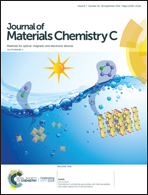High efficiency blue/green/yellow/red fluorescent organic light-emitting diodes sensitized by phosphors: general design rules and electroluminescence performance analysis†
Abstract
Fluorescent organic light-emitting diodes (OLEDs) still suffer from the problems of low efficiency and efficiency roll-off. As one of the strategies, the phosphor sensitized fluorescence approach has been proven to be an effective route to solve these problems. Here, we proposed the general design rules for phosphor sensitized fluorescent OLEDs that realize high efficiency and low roll-off. It has been demonstrated that besides an efficient energy transfer, the used phosphor sensitizers still require deeper highest occupied molecular orbital (HOMO) levels that can effectively trap holes than the used fluorescent dopants. Thus, the fluorescence emission with approximately 100% exciton utilization has been well achieved. The external quantum efficiencies (EQEs) of the resulting OLEDs were as high as 12.1%, 13.1%, 17.0% and 18.9% of the maximum value, and remained 11.5%, 10.3%, 14.3% and 15.4% at 1000 cd m−2 luminance for blue, green, yellow and red emission, respectively. Our results provided a clear approach to realize high efficiency and low efficiency roll-off fluorescent OLEDs, helping to overcome the limitation in the efficiency of fluorescence emission.



 Please wait while we load your content...
Please wait while we load your content...